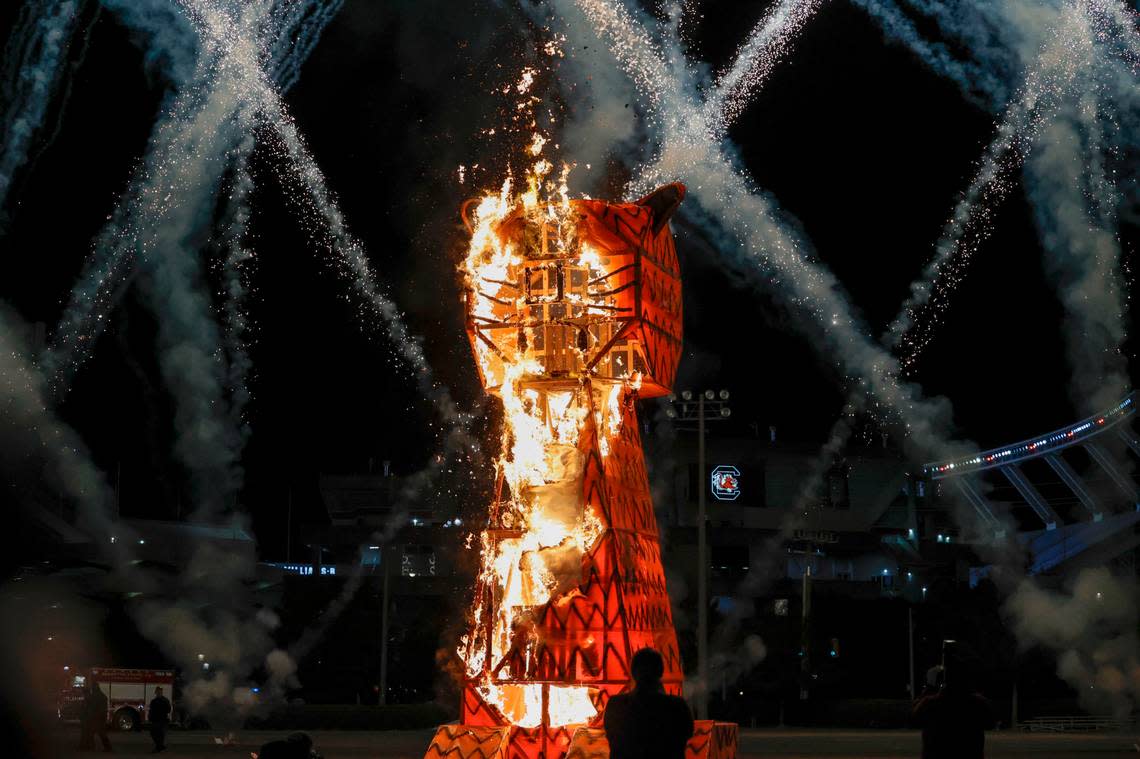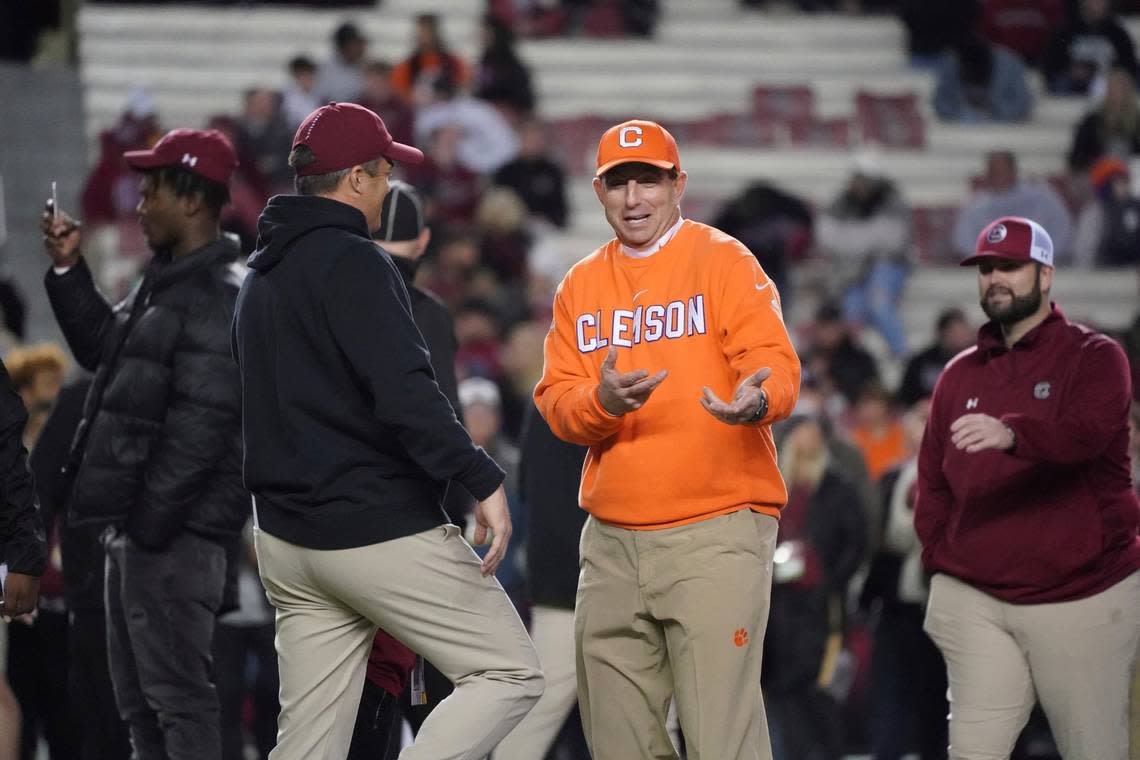Future of South Carolina-Clemson game seems certain as college football faces change
Tom Regan is a Wyoming Cowboy to his core. He completed his undergraduate work in Laramie while playing baseball for the school before it disbanded the program in 1996.
The last 31 years, though? Regan, an associate professor at the University of South Carolina and an expert on the economic impact of sports, has had a front row seat to what the USC-Clemson game has done for the Columbia area.
“Our priest talks about it at Mass,” Regan quipped. “(He’ll say), ‘Well, I guess we’re gonna have to go to the Upstate.’ I always used to laugh, our Irish priest in Montana always talked about Notre Dame. But down here, these guys always just talk about those two schools.”
Those higher powers most involved in the South Carolina-Clemson football rivalry assure that, amid the incessantly changing landscape of college sports, the game isn’t going anywhere.
The most recent threat to the annual showdown comes via conference expansion and the potential ramifications of a new nine-game Southeastern Conference slate that would force South Carolina to drop one of its four nonconference games.
The changes that could come to USC’s schedule? We’ll see.
“Whether it’s Florida-Florida State, or Southern Cal-UCLA, different people say they’ve got the greatest rivalry,” South Carolina athletic director Ray Tanner told The State. “I think, truly, ours is a great rivalry in lots of sports. I wouldn’t want it to change in any capacity.”
There have been 118 editions of South Carolina-Clemson, known in varying iterations as Big Thursday or, more recently, the Palmetto Bowl. The game was played continuously from 1909 through both World Wars and up until 2020, when it was canceled amid the COVID-19 pandemic. It ranked as the second-longest continuous rivalry in college football behind only Wisconsin-Minnesota.
Those contests have bred men who’ve become part of Gamecock and Tiger lore. Steve Tanneyhill and Steve Fuller. Stephen Garcia and Woody Dantzler. Moments like The Prank and The Catch are ingrained in the bedrock of the series.
In a state without any major professional sports franchises, South Carolina-Clemson is the game.
“Clemson, of course, is the in-state rival game that we’ve been playing for what? One hundred years or more?” former South Carolina head coach Steve Spurrier told The State. “It’s a huge game. Bragging rights for the whole year.”

The impact of the Clemson-South Carolina football game
Representative Nathan Ballentine groans thinking back to his earliest memories of the Clemson-South Carolina rivalry.
The 1992 USC grad and member of the South Carolina House of Representatives was in Death Valley in 1980 when Willie Underwood swiped a pair of interceptions in Clemson’s downing of USC and Heisman Trophy winner George Rogers.
“I remember, as a kid, seeing the fans swirling rubber chickens around,” Ballentine joked. “And I was just like, ‘Oh my gosh, I can’t stand this place.’ ”
Twenty years after watching that Gamecocks loss, Ballentine introduced bill H 4525 in the South Carolina General Assembly. It read as follows:
“A BILL TO AMEND THE CODE OF LAWS OF SOUTH CAROLINA, 1976, BY ADDING SECTION 59-101-435 SO AS TO PROVIDE THAT THE DIVISION I VARSITY FOOTBALL TEAMS OF THE UNIVERSITY OF SOUTH CAROLINA AND CLEMSON UNIVERSITY SHALL ANNUALLY PLAY ON A HOME AND HOME BASIS UNDER SUCH TERMS AND CONDITIONS AS THE RESPECTIVE BOARDS OF TRUSTEES MAY DECIDE.”
Ballentine’s effort to make sure the rivalry game is always played, which was voted down 7-0, wasn’t the first time the government has dipped its hand in the South Carolina-Clemson football contests. Clemson was put on probation in the early 1950s by the Southern Conference. As part of its punishment, the Tigers weren’t allowed to play members of the league — the Gamecocks included.
That was quickly rectified when the South Carolina General Assembly passed a resolution to make sure the USC-Clemson series continued.
“We’re naming the peanut our state snack and milk is the state beverage,” Ballentine told The State. “I think that making sure this game is played is more important than a peanut being the state snack.”
That Ballentine’s bill didn’t pass wasn’t so much a failure as a look at the immense intersection between state political institutions, the economic impact of the annual game and what it means to the respective communities.
Tanner and Regan both estimate the economic impact on the city of Columbia metro area is in the neighborhood of $7 million every time Clemson comes to town. Regan notes that’s almost $1 million more than the average USC home football game draws.
Just scan ticket prices for this week’s game at Death Valley and you’ll see why. A single ticket in the uppermost portions of Memorial Stadium, as of Tuesday, ran for $134 before fees on the secondary market.
That’s not to mention the hotel rooms, dining and other activities that accompany a weekend football trip that have significant value to local businesses in the Columbia and Greenville-Spartanburg-Anderson areas.
“It’s national exposure for both our universities,” Tanner said. “It’s a branding opportunity. That does so much for both schools. You can’t pay for that kind of advertisement. It’s spectacular.”

The coming SEC scheduling changes and what’s next
The SEC has yet to announce official scheduling format changes, but the belief is the league will eventually move from its current eight-game conference schedule to a nine-game format that would incorporate three permanent opponents for each school and eliminate the current divisional structure.
Given that Clemson falls outside the SEC’s purview, that means playing the Tigers each year would take up one of South Carolina’s three nonconference games in the new format.
“The SEC has studied going from eight to nine league games,” Clemson athletic director Graham Neff said during a meeting with the Orangeburg Touchdown Club, per the Times and Democrat. “But I can’t imagine a circumstance that causes the rivalry to go away.
“In short, the answer is no. There’s four rivalry games between the [ACC and SEC], (Clemson-USC, Georgia Tech-Georgia, Louisville-Kentucky and Florida State-Florida) and all would have implications.”
USC is believed to be among the SEC teams split on the decision to move to nine games, preferring the current eight-game conference slate instead.
South Carolina’s schedule — before adding a ninth SEC game — already ranks among the toughest in college football annually. An SEC slate plus ACC power Clemson is a challenge in itself. USC also has nonconference games scheduled against other Power Five opponents in eight of the next nine years — including North Carolina, N.C. State, Miami (Fla.) and Virginia Tech.
There is, however, language in the contracts with a handful of South Carolina’s future opponents that would allow wiggle room for USC should the SEC change its current scheduling structure.
South Carolina’s contract with North Carolina for games in 2028 and 2029, for example, notes that “any requirement issued by the NCAA or respective athletic conferences to reduce or limit either institution’s intercollegiate football schedule that makes it impractical to play the GAME(S) will be considered force majeure.” A “force majeure” clause typically allows a party to break a contract, often without financial penalty.
USC and Clemson completed a four-year agreement in 2021. The schools are currently in the first year of a two-game deal that calls for contests in 2022 and 2023. It doesn’t include any of the aforementioned language, but any SEC scheduling changes likely won’t go into effect until Oklahoma and Texas join the league as early as 2024.
“It does,” SEC commissioner Greg Sankey said at the league’s spring meetings in June as to whether out-of-league rivalry games have factored into the scheduling discussions. “We’ve done a good job of honoring those.
“You have to remember that, over time, if you go back and look, Kentucky-Louisville was an early season game. It’s now a late-season game. We used to have some rivalry games played the week before Thanksgiving — I mean in-conference rivalries. We’ve adapted over time and that’s part of the care that’s being given to how we determine the outcome.”
The South Carolina-Clemson game hasn’t been immune to change over the years. Played exclusively in Columbia on the Thursday of state fair week — the third Thursday in October — over the first 57 years of the rivalry, it was moved to rotating between USC and Clemson starting in 1960.
Asked if there was any world where the game could shift away from the current end-of-season slot it occupies, Tanner said his preference was to keep it as is.
“I like where it’s at, but with the ACC and the SEC, there could be a movement in both conferences that would put us in a situation that we would have to reconsider scheduling,” Tanner said. “I’m hopeful that we can stay where we are.”
South Carolina-Clemson week brings out the most zealous of fans from either corner of the rivalry. Those at Clemson hold a ritual called Cocky’s Funeral. On USC’s campus, a Tiger effigy is burned.
College football is changing. Rivalries like Oklahoma-Nebraska and Kansas-Missouri have largely gone by the wayside. The Backyard Brawl between West Virginia and Pittsburgh returned this fall following an 11-year hiatus.
Conference realignment and shifting landscape aside, South Carolina-Clemson should remain a central piece of college athletics in the Palmetto State — and a popular talking point at Mass.
